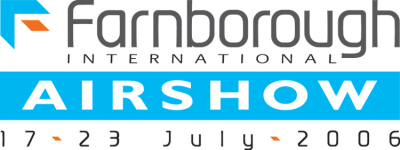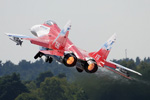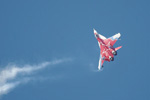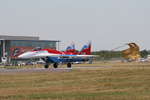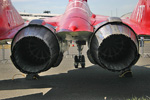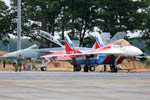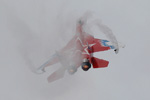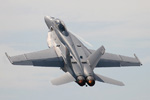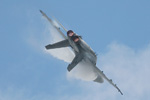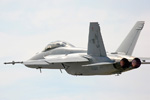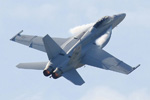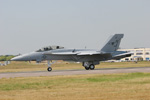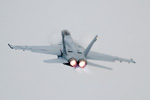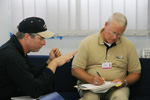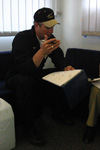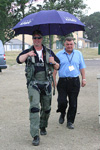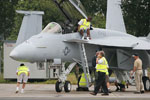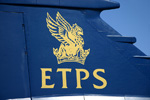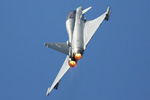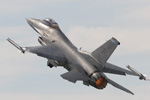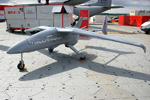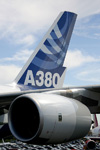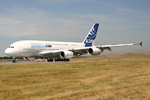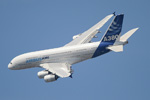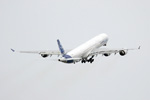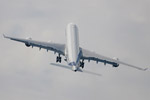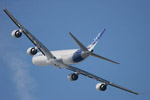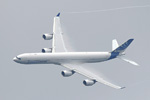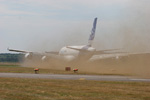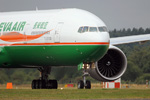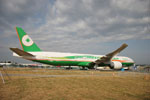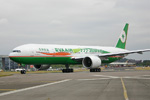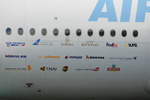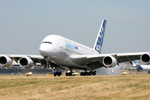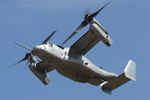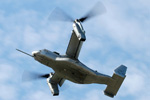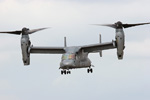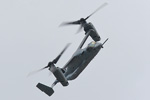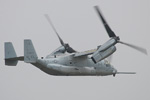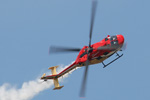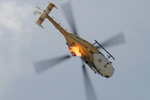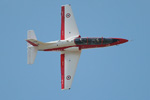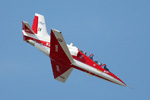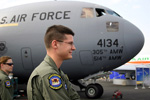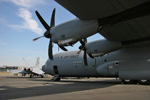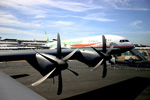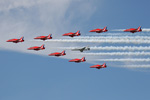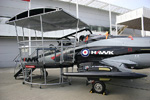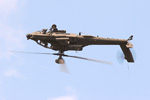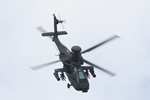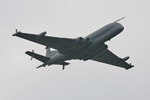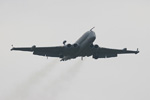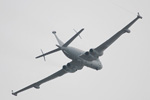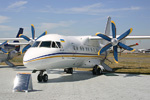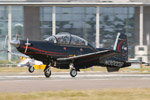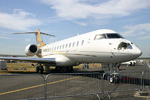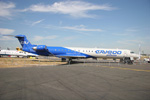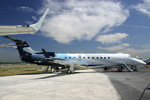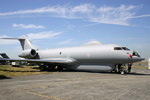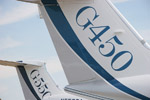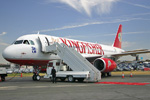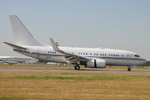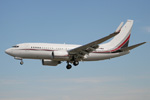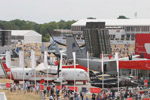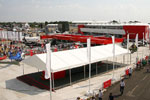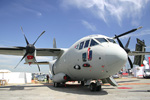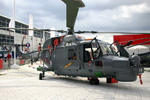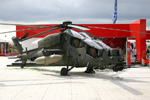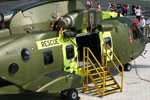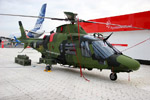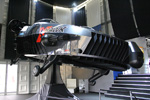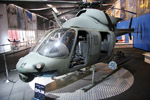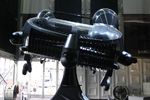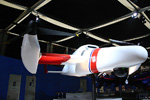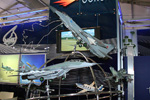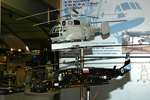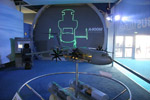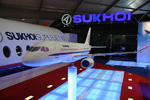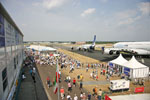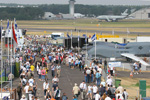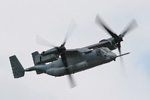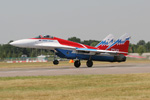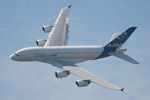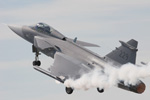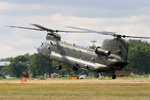RSK
MiG didn’t just send along anybody to fly their pride and joy...
at the helm of this garishly coloured “Super Fulcrum” for
the numerous displays were none other than the RSK MiG Chief Test Pilot
‘Hero of Russia’ Pavel Vlasov or his colleague, Mikhail
Belyaev. During the demo, the Fulcrum did things that one would think
were damn near impossible for even the likes of an Extra 300, let alone
twelve tonnes of metals and composites that are capable of hitting Mach
2.2. Awesome isn’t a strong enough word to describe it. Cobras
are now not exactly Cobras but more correctly defined as a full 360º
“backflip” and at one point during the terrific routine,
as the jet completes one backflip and begins to lose altitude, it drops
into another. To make it easier for the Mk 1 eyeball to discern just
what was happening, two wing mounted smoke generators meant you could
see which way the jet was going and on more than one occasion, the smoke
was actually coming off the edge of the rear wing at 90º to the
direction of travel. On the subject of manoeuvre names, RSK MiG ran
a competition at Farnborough for visitors to name four of the new and un-named tricks
performed in the display; with the prize being a trip to Moscow to have
a ride in a MiG-29. Quite simply, I haven’t ever seen anything
like it. Someone ought to tell the good people at RSK MiG that the numerous
laws of physics do in fact apply to them and their aircraft too. However, if this is what
they can do with a thirty-two year old design; God only knows what they
can do with a blank sheet of paper and new pencils. It also bodes well
for the Indians as the MiG-29M and MiG-29M2 are competing in the MRCA
competition to replace ageing MiG-23MFs Flogger-Bs and their OVT is basically
a developmental platform for the M/M2s. |
|
|
F-22A
Raptor not withstanding, it’s perhaps not going too far to state
that the most agile and awe-inspiring jets that the World’s aviation
companies have to offer were on the bill. The F/A-18F, already proven
to be a supremely agile jet, was represented by two brand new examples
assigned to the first ever unit to operate the Super Hornet –
the west coast F/A-18E/F Fleet Replacement Squadron, VFA-122 “Flying
Eagles” from NAS Lemoore in California. Although sadly lacking
any hi-viz CAG or XO jet paintjobs a la the VFA-2 “Bounty
Hunter” F/A-18Fs of 2004, these two jets were about the latest
Super Hornets that Boeing could get their hands on, bar the Block 2
AESA equipped jets flown by VFA-213 “Black Lions”
at Oceana. Your average common or garden F/A-18E/F is a perfectly capable
platform for putting ordnance on target – already most precision
munitions in the US arsenal are cleared for the Rhino yet the Block
2 jets take this a little further. What this seemingly innocuous “Block
2” means is that the older AN/APG-73 radar has been replaced by
Raytheon’s newest box of gadgetry, the AN/APG-79 AESA, the jets
are now able to fully use the Raytheon ATFLIR targeting pod and a Link-16
datalink. The APG-79 is the first AESA radar (and that includes the
AN/APG-77 in the Raptor) that permits almost simultaneous use of the
air-to-air and air-to-ground modes in any US aircraft. It also offers
further significant advantages over the APG-73 in so much as it has
greater range, an ability to track more targets and even pass targeting
information for munitions such as JDAMs to other jets that may or may
not have their own AESA radars. Whilst a Tomcat it ain’t, a Block
2 F/A-18F (most Block 2 jets will be twin-seat Fs rather than single-seat
Es) with developments of the AMRAAM will be able to offer a Carrier
Strike Group greater cover than current carrier borne assets thanks
to the improved radar and longer ranged AIM-120s. However, the Block
2 electrickery doesn’t bring anything extra to the agility table
and any Super Hornet can be quite an airshow performer. |
Ricardo Traven, Boeing’s F/A-18E/F Chief Test Pilot and the maestro that simply blitzed the opposition for the RIAT King Hussein Memorial Sword and As The Crow Flies trophies in 2004, was once again at the helm of the USN’s primary strike-fighter with the intention of flinging it about the Hampshire skies. However, unlike 2004 where the jet was almost fully tooled-up with four AIM-120s and two AIM-9s, the 2006 demo would be conducted with a clean jet to create, in the words of the man himself, “a faster, more dynamic show with all the high-angle-of-attack and signature maneouvres that only a Boeing F/A-18E/F Super Hornet can do.” Between the rather impressive short take-off departure and carrier style “fly it into the deck for a controlled crash” landing, Ricardo really did a fantastic job of showing off just how agile the Rhino actually is. Bar any MiG-29M OVT-only tricks, Ricardo did pretty much everything else possible in a currently displayed fast jet and actually said he intended to “fly the wings off” the thing on the opening day of the show. 2004 saw superb displays at RIAT and Farnborough – 2006, well, it’s better. Although four AIM-120s dangling from the wings does look better than a clean jet, the reduction of drag and weight does seem to have had a marked effect on the ability of the Rhino to make big holes in the sky. When Boeing put together the Super Hornet, you’d think they’d deliberately designed it for airshows! Ignoring the eye-watering thrust-vectored stunts of the Fulcrum, which will probably take witchcraft to beat, the Super Hornet can be fairly considered as perhaps one of the finest jet demonstration of recent years. |
|
|
Ricardo’s
briefings also have to been seen to be believed; sitting with the coach,
Franklin Green, Ricardo actually describes in massive detail, even down
to airspeed, altitude and timings, his display and what he would do
given something failed – such as an engine flame-out. Both high
and low shows are discussed in the same fashion, as was the point at
which the decision would be made to continue with the high show or switch
to the low. Watching and listening to this brief is, quite simply, watching
a genius at work although without the massive support provided by the
rest of team, Ricardo wouldn’t have a serviceable jet to fly in.
All are employees of Boeing, rather than the US Navy, and this small
team spends all sorts of hours for weeks on end ensuring the jets work
when Boeing needs them to work. Given the thunderstorm and torrential
downpour that rolled in just as Ricardo was strapping on the jet, it
was obvious that Saturday would see the low show and, whilst it shouldn’t
be quite as good as the high show, the very high humidity and dark skies
made for a thoroughly entertaining display thanks to the Rhino’s
ability to generate its own clouds, pull off manoeuvres you’d
think it couldn’t do and the uncanny ability of the F414-GE-400
engines to turn kerosene into vast amounts of noise is a bonus. In a
further nod to Boeing’s intentions with the Super Hornet, two
HAL test pilots, Air Marshals AK Nagalia and Bhushan Gokhale (the Rhino
is going toe-to-toe in the Indian MRCA competition with the MiG-29M/M2),
got to fly the Rhino in the skies of the UK and after leaving Hampshire,
the jets didn’t go home, they went to Bulgaria following a RFI
(Request For Information) issued to Boeing for the F/A-18E/F. With 462
Echos and Foxtrots going to the US Navy (the only operator of the type,
although the original request was for about twice as many) with an extra
90 EA-18G Growlers replacing the EA-6B Prowler, it’s not as if
Boeing need to export the Rhino but obviously a sale is a sale –
one can only wonder how the Super Hornet would look in Indian or Bulgarian
markings! Other potential export customers could include Switzerland,
Spain, Kuwait, Finland, Japan and Australia. |
In
what was considered a slight surprise due to what would be in attendance,
the F-22 wasn’t brought across to join the party. The omission
left Lockheed to face the Super Hornet and down-right crazy MiG-29M
OVT with the venerable F-16 which didn’t seem all that fair to
be honest - it can't touch the F/A-18E/F, let alone the MiG-29M OVT. The F-16 type chosen was the Block 50, provided by the Spangdahlem-based
23rd FS “Fighting Hawks”, rather than a new Block
60 F-16E/F. Granted the performance of the F-16CJ is perhaps slightly
better than the heavier F-16E/F thanks to, amongst other things, a standard spine and lack
of conformal fuel tanks yet a shiny new UAE AF Block 60 Viper would
have been quite an addition to the show. Flown by Troy Pennington and
Bill Gigliotti, both Lockheed test pilots and with fitted with just
a pair of smokewinders, the displays didn’t quite have the measure
of the best the European Viper nations had to offer although they were
quite impressive. Eurofighter GmbH and Gripen International, in their
own backyards, couldn’t be seen to let the Americans and Russians
sew up the fast jet displays and duly stepped up to oche wielding
a Typhoon and JAS-39C Gripen. The Typhoon would be flown by 29(R) Squadron’s
Sqn Ldr Matt Elliott whilst the Gripen would be flown by Fredrik Müchler,
an ex-Swedish AF Draken and Team 60 pilot who has more than 1,000hrs
on the JAS-39 and 3,700hrs in most Swedish AF types including the Sk60,
Draken, Viggen and Gripen. The two Europeans did an admirable job of
demonstrating their products although both had the edge knocked off
the displays by displaying at a seemingly greater height whilst, due
to the slightly smaller size, the Gripen suffered more than the Typhoon
did. Gripen International and SAAB didn't just feature in the flying
display - to support the announcement about QinetiQ's Empire Test Pilots
School using the Gripen as their advanced fast jet platform, a JAS-39B
had some blue emulsion splashed on the tail and down the spine and finished
off with gold ETPS Griffin logos on either side of the tail. Although
the Gripen has been part of ETPS schooling for 7 years, this announcement
sees a 30% increase in student numbers, a 20% increase in flights per
student (for a total of 12.5 hrs), the inclusion of a third ETPS Gripen
IP and the inclusion of Flight Test Engineer students. Students get
simulator time at the Swedish AF’s F7 Wing facility at Såtenäs
and will undertake all flights from Saab’s facility at Linköping. |
|
|
One
thing that Eurofighter pulled off was a second Typhoon display although
this time round with a T.1 fully loaded with six Paveway LGBs. Mark
Bowman, the BAE Systems Typhoon Project pilot made a very good showing
for the bombed-up Typhoon and, strangely enough, it coincided with the
day when Ultra Electronics were awarded a £56M contract to provide
Rafael Litening EF (Gen III) targeting pods for the RAF Typhoons. Whilst
buying the pods direct from Israel would no doubt ultimately achieve
the same goal, the terms of the agreement include a technology transfer
such that Ultra can update and upgrade the pods without Rafael over
a period of 20 years. These pods, in addition to the obvious designation
of ground targets, also permit air-to-air targeting, ground reconnaissance
and have a FLIR to permit low-level night-time and adverse weather flying.
Still on the subject of the Typhoon, a welcome addition to the static
was that of a single Italian 4º Stormo Typhoon in the Finmeccanica
exhibition area – an area which featured various types of aircraft
and UAVs all adorned with World Cup 2006 winners artwork. Another jet
conspicuous by its absence was the Dassault Rafale. In light of the
fact that Farnborough is a trade show and Dassault are desperate to
get the Rafale onto the world export market, it did seem just that little
odd that it was missing. It would have also given the chance to compare
pretty much all the jets on the various “we want a new fighter”
lists of several nations around the World on a level playing field yet
irrespective of the relative pros and cons of each type, comments overheard
during the course of the show suggested that your average airshow goer
is as impressed with the Typhoon or Gripen as he or she is with the
physics-ignoring shenanigans of the MiG-29M OVT. |
However,
it wasn’t all afterburners, high-g this and barrel-roll that during
the display… Airbus, as was expected, brought their two biggest airliners with them.
Those two heavyweights being the very long and seemingly quite thin
A340-600 and the shorter but much, MUCH fatter A380-800 double-decker
super-jumbo; both featuring Airbus Industries house colour schemes rather
than any particular airline scheme. Having never seen, except in photos,
the A380 before, all I can say is “WOW”. It is a whole different
kind of enormous. Whilst similar in length to the 747-400 and a little
wider, wingspan wise, the full-length double-decker fuselage and immense
tail make the A380 look massively bigger than the older Boeing passenger
hauler. Parked on the cross runway next to this behemoth was the A340-600
which compounded just how big the A380 is. Although the tube-like A340-600
is much longer than its younger brother, the A380 is almost 40% taller
(tail height) and has a wing area that is only a little shy of twice
that of the A340-600. What’s even more shocking is the weight
of the things considering both can start at, for instance, Heathrow and end up roughly
15,000km away on just the one tank of fuel – the A340-600 tips the scales
at a maximum of about 380 tonnes whereas the A380, which makes use of
new lighter-weight composites, comes in at a truly massive 560 tonnes
and is roughly 100 tonnes heavier than the A340-600 when empty. Like I said, HUGE!! Just
thinking of customs delays, we can only hope no-one decides to take
an A380 and stuff it full of economy-class seating as that will mean,
when it comes to getting off, there could be 852 people between you,
immigration and passport control. That’s the type of delay that
two 747-400s could create! Given a typical layout, well, “typical”
according to Airbus, there’d only be 554 in front of you which
isn’t quite so bad! Thus far, 159 of the $300M giants have been
ordered by 16 customers worldwide, with just Virgin Atlantic representing
the UK airlines, although about another 100 need to be sold for Airbus
to break even. |
|
|
Whilst
obviously all the attention at the show was focused on the A380, the
A340-600 had conducted a spirited display although it does have to be
said - the A340-600, thanks to its massive Smarties tube looks, does
look a bit, well, strange. Airbus must really look forward to these
trade shows as once again the A340 was thrown around the skies of Hampshire
with Claude Lelaie seemingly having little to no regard for the laws
of airliner physics. The landing on Monday was somewhat eye-opening
as the main wheels were brought into contact with terra firma with quite
a thump at not far off the half-way mark of the runway. Comments of
"it's not gonna stop from there!" and "how are they going
to stop that?" and so forth were overheard but stop it they did
although two orange-flashy-light equipped vehicles, chasing the A340
down the runway at a fair rate of knots, implied not everything may
have been entirely as it should. No real emergency vehicles, by that
I mean the big red trucks with the blue lights, ventured out so one can
only presume the result was that the landing was a little harder than
normal but not a problem. |
Following a relatively short take-off into a tight bank to starboard, a redistribution of a vast amount of grass cuttings over most of the county and with Deputy Project Pilot Peter Chandler (a former A340 pilot with Virgin Atlantic) in the pilot seat, the A380 proved itself to be a surprisingly capable performer which isn't quite what you expect from something that looks so unwieldy. In perhaps the biggest shock, the massive airliner actually performed a low-speed high-alpha pass! Amazing. Another surprise was just how quiet it is... you would expect an aircraft the size of a small African nation with its four massive engines to sound more like some kind of party than a library but at times you just can't hear the thing which must surely come as a blessing to those fearful of A380 operations. The four Rolls-Royce Trent 970s, the biggest engines Rolls-Royce have ever built, together can muster 280,000lbf of thrust although A380s could, and probably will, feature Trent 900 versions capable of providing a total of 336,000lbf. Thus far, roughly half of all A380s will be fitted with the Trent 900 whilst the rest will be fitted with the competing EngineAlliance (a joint GE and P&W company) GP7200 which has similar specifications to the Trent 900. Logic or common sense would suggest that airliners shouldn't be able to do what these airliners did and for that, Airbus have to be congratulated. They also managed to show off their two giants whilst the green and white Boeing 777-300ER (also capable of 14,000km+ flights) of Taiwan-based EVA Air remained firmly on the tarmac until it left on the Sunday morning. |
|
|
Remaining
on the topic of Airbus, Farnborough also saw the announcement of a whole
new airliner from the Toulouse gang. The A350XWB, or Xtra Wide Body,
will be a brand-new airliner designed to go head to head with Boeing's
787 "Dreamliner" which has thus far done quite well for itself
in gaining sales even though it is currently a little overweight. Singapore
Airlines are yet again first off the starting blocks with an Airbus
jet and have placed a firm order for twenty XWBs with options for twenty
more. With a fuselage wider than the 787, the A350XWB should be able
to offer passengers greater comfort thanks to more space and the three
versions (the -800, -900 and -1000) can offer seating for between 270
and 350 passengers over distances of up to almost 16,000km with a maximum
speed of Mach 0.85 which is pretty much what the 787-8 and 787-9 are
capable of. In terms of orders announced by both major airliner players,
Airbus announced 182 orders from twelve customers for what were predominantly
A320s and A330s; Boeing on the other hand have 79 firm orders, most
of which were for the 737-800 & -900, the rest being 747s and 777s
so sold more large aircraft than Airbus did. In terms of total orders,
1480 exhibitors from 35 different countries and 110 different airlines
sent representatives to the show which eventually recorded more than
$42B in sales which is exactly double the $21B announced for the orders
taken at the 2004 show. |
The
award for the strangest looking attendee at the show must surely go
to Bell-Boeing Textron’s MV-22B Osprey. Bar, that is, the down
right crazy Bell X-Hawk mockup but I’ll get back to that later
on. Designed to combine the relative merits of helicopter (VTOL) and
turboprop aircraft (greater range and a higher cruise speed) operations,
the 24 ton V-22 is the World's first production tiltrotor and comes
after a problematic twenty year development that has cost a not inconsiderable
$30B. Mid-2005 saw the Osprey successfully complete its final OPEVAL
which included high altitude, high temperature, desert, shipborne (aboard
LHD-5 USS Bataan) and long range operations which was the precursor
to the Pentagon announcing full-rate production. The UK appearance of
the Ospreys, in addition to being shown off to potential customers at
RIAT and Farnborough and the kick start to a sales drive, would allow the Osprey to demonstrate the ability
to self-deploy over several thousand miles – something the currently used force of ageing
CH-46E Sea Knights cannot do. The sixteen hour flight was conducted
by VMX-22 crews and involved a stop in Canada prior to actually hopping
over the Atlantic. However, all was not entirely sweetness and light as
when the two VMX-22 Ospreys and their two VMGR-252 KC-130J tankers were
heading to the UK from Canada, one of the Ospreys suffered from a compressor
stall in one of the engines so diverted into Keflavik. The little hiccup
with the engine was remedied relatively easily by swapping the duff
engine with a spare that had already been pre-positioned in the UK;
this meant the poorly Osprey could then join its squadron mate at Farnborough,
albeit 36 hours later and, once here, reliability didn't seem to be a problem for either machine. |
|
|
In
total, there will be 360 MV-22Bs for the USMC and 50 CV-22Bs for the
USAF with a future requirement of 48 HV-22Bs for the USN and the possibility
of some UV-22Bs for the US Army. The first operational squadron will
be the USMC’s VMM-263 "Thunder Chickens" based
at MCAS New River alongside the two pre-existing squadrons of VMX-22
"Argonauts" (the test and development squadron) and
VMMT-204 "Raptors" (the MV-22 training squadron)
and should see operational duty in Iraq in 2007. Eventually all CH-46
units at New River will transition onto the MV-22 with VMM-162 "Golden
Eagles" being the next one to stand up as an operational Osprey
unit. The first thing you think of when faced with a V-22 is “that
shouldn’t fly”... it just looks like it shouldn’t
fly yet thanks to two Rolls-Royce AE1107C engines that each provide
6,150shp to 38-ft diameter foldable rotors, fly it does. Noise wise,
you’d expect it to sound Chinook-like but it creates a somewhat
odd sound that lies somewhere between that of an idling tractor and
a Puma yet isn’t quite as loud as you’d think it would be
(which must help the Marines sleep at night knowing they won’t
be going into combat in a flying klaxon). The pilots, Bell’s Marty
Schubert and Boeing’s Steve Grohsmeyer, took turns to display
the Osprey and showed off the unique abilities of the tiltrotor by amply
demonstrating both helicopter and aircraft ‘modes’ and the
transition phases between the two. It has even been said the demos of
the Osprey were about 60% of what the thing can really do – I’d
love to see the other 40% of what it can do now, let alone after VMX-22
crews have been busy playing with the rule book for another few years!
One further ‘oddity’ was the paint scheme, both MV-22s were
resplendent in a very smart two-tone IR/radar signature reducing silver
scheme rather than an expected “tactical grey” and the peculiar
machines really did look extremely good in the sunshine. Normal Corps
Ospreys will be painted in the aforesaid tactical grey and not the silver
finish which will stay within VMX-22. |
In
what amounted to yet another first for Farnborough, the booming Indian
aviation industry was represented by the Hindustan Aeronautics Ltd (now
in the top 50 of the top 100 worldwide aviation companies) AJT-36 Sitara
intermediate jet trainer and the troubled Dhruv light helicopter, two
of each arrived in Hampshire aboard an An-124 Condor. The Dhruv is basically
an indigenous Indian light multi-role helicopter that is small, agile
and adaptable to a considerable number of roles and actually looks quite
similar to the Eurocopter/Kawasaki BK-117. First announced way back
in 1984, the first prototype flew in 1992 yet deliveries of the 300
helicopters ordered by the Indian Air Force, Navy, Army and Coast Guard,
Nepal and Israel didn’t actually start until 2002. The Dhruv is
capable of carrying a 20mm gun, eight anti-tank missiles or four unguided
rocket pods in the army and air force guises or two torpedoes, depth
charges or anti-shipping missiles in the naval guise. Initial reports/rumours
claimed that the Dhruvs at Farnborough would be demonstrated by the
Sarang display team but this wasn’t entirely accurate –
the display was flown as a single ship with a second fitted out with
various munitions and left in the static park although both were wearing
the eye-catching peacock scheme of the Sarang team. Display wise, Wing
Commanders Hari Nair, Unni Pillai and C. D. Upadhyay (HAL’s
Chief rotary wing test pilot) certainly know their stuff and went on
to prove just how nimble the Advance Light Helicopter really is although
it is enhanced by the use of smoke generating pods – which can
cause a little surprise when the said generator “flames out”.
HAL also displayed their light jet trainer alongside the ALH, intended
to replace the 42-year old AJT-16 Kiran and provide a stepping stone
onto modern aircraft like the Su-30MKI (and if Boeing get their way,
the F/A-18F), the AJT-36 has had a development life almost completely
opposite to the Dhruv –development work began in 1999 and just
four years later it made a successful first flight at HALs Bangalore
plant. As a tiny jet, at times, the Sitara seemed to just get ‘lost’
in the skies over Farnborough yet nevertheless proved to be a reasonable
display with manoeuvres typical of a small jet trainer demonstration.
The awful weather on Saturday wasn’t enough to keep Boeing on
the ground but it was enough to keep the IJT team on terra firma –
the jet actually made it to the runway yet aborted the take-off due to the awful weather. |
|
|
Static
wise, the main focal point with the exception of the A340 and A380,
was the US Department of Defense Corral from which the rest of the static
line-ups radiated. The DoD Corral is basically a collection of US aircraft
all located together and was this year dominated by the imposing 815th
AS "Flying Jennies" stretched C-130J from the 403rd
Wing at Keesler AFB with single examples of the F-16C, F/A-18F, F-15C,
F-15E and UH-60A located round it. Looking on over the said corral were
EVA Air’s 777-300ER, the 6th AS "Billy Beef Express"
C-17A and a tiny, in comparison, replica of an X-46 N-UCAV. Of the fast
jets in the corral, the best turned out machine was the VFA-122 F/A-18F
as, to show off its truly multi-role ability, it was pretty much fully
tooled up with quite an arsenal of [dummy] weaponry. AIM-9X Sidewinders
populated the wing-tip rails, AIM-120 AMRAAMs on the two fuselage stations,
AGM-88E AARGMs (the Advanced Anti-Radiation Guided Missile is the latest
multi-mode version and successor of the AGM-88 high-speed anti-radiation
missile which can now not only take out the radar but, thanks to the
addition of an MMW seeker, it can also be used to take out the control
vehicle which the HARM couldn’t do) were located on the outermost
wing pylons, inboard of these were 2,000-lb GBU-31 JDAMs on the centre
pylons and 2,000-lb GBU-24/B Paveway III LGBs on the innermost pylons
with a fuel tank hanging from the fuselage centreline. On display with
the Rhino, well, within the DoD Corral, was quite a range of ordnance.
You could maybe argue that the three strike aircraft within the corral
could all quite easily employ the weapons but it was quite clear they
were part of the Boeing master plan to get the Super Hornet onto the
international market with a big "look what we can do!".
|
However, on Monday morning, you could have quite justifiably assumed Boeing had got all creative as most of the munitions were displayed alongside the C-17A... although the USAF do want a new bomber by 2018, we're quite sure that there aren't any C-17s flying with AARGM capability or with some kind of fancy bomb rack mechanism inside the cargo hold. The venerable JDAM was represented by the GBU-38/B, GBU-32(V)2/B and GBU-31(V)2/B together with the latest in precision munition deployment - the BRU-55 Smart Bomb Rack. This innocuous looking device basically enhances the hitting power of the jet from which it dangles by allowing two 1,000-lb weapons to be hung from a suitable pylon. However, it also allows fully independent targeting and release of each weapon. The first of 135 such racks was delivered by EDO to the USN on the Friday of the show and will eventually feature in the arsenal of all USN F/A-18 types. Whilst capable of hauling a pair of GBU-32s, the modern way of doing things (that is the act of trying very hard to avoid collateral damage) would imply that the BRU-55 will primarily be used hand-in-hand with GBU-38 500-lb JDAMs. Where, previously, a certain jet could have carried say two under each wing, it can now carry four for a total of eight. The strangest looking munition on display was the AGM-84K SLAM-ER ATA – the latest version of the Stand-off Land Attack Missile. This thing, equipped with pop-out wings and a rather strange looking chiselled nose housing the electro-optical wizardry, is to all intents and purposes a cruise missile. One that is more than capable of taking the 500-lb class warhead more than 150 miles from the point of launch and putting it wherever it needs to be with impressive accuracy. The SLAM-ER was alongside its ship-killing sibling, the RGM-84L Harpoon, which is the export version of the Block II Harpoon and although similar in size, the Lima lacks the pop-out wings and funny nose of the SLAM-ER yet is good at what it does - giving enemy warships a serious head-ache. Thanks to various bits from the SLAM, the Lima can also give shore-based targets a good going over too. |
|
|
Three
newish BAe Hawks were also out and about, one being the first of six
Hawk 129s for the Royal Bahraini AF, one being a Hawk 120 in the BAE
Systems pavilion and the other being a Hawk T.2. The RBAF Hawk 129,
an improved Hawk 127 and intended to
improve both the quality and number of RBAF F-16 pilots, was handed
over to the Crown Prince of Bahrain, Sheikh Salman bin Hamad bin Isa
Al Khalifa, on Monday morning after BAE Systems test pilot Nat Makepeace
and Lt Col Omar Ebrahim Mohamed Al Mahmood flew it in an impressive
formation with the Red Arrows in front of the assembled Bahraini delegation
which also included the RBAF Commander, Col Shaikh Salman bin Hamad
Al Khalifa. Taking pride of place in the impressive BAE System pavilion,
the Hawk 120 features benefits taken from the Mk 127 and is basically
similar to the Hawk 129 although this one featured a much more stylish
black, red and silver paint scheme rather than the grey chosen by the
Bahrainis. The third and final new Hawk was the T.2 down by the crowdline.
The T.2 is the designation given to the Mk 128, selected as the RAFs
"Advanced Jet Trainer" and, due in no small part to an advanced
fully-glass cockpit, is intended to train aircrew to fly the Typhoon
/ F-35 and features a laser range finder and FLIR in the new elongated
and, frankly, strange-shape snout. |
An
extremely welcome addition to the static park (technically the Eurocopter
pavilion) was one seriously rare visitor to UK shores – an EC.725HUS
Cougar. Like several other “trade days only” attendees,
the said Cougar didn’t hang about for the public show days and
left on Saturday morning which did at least mean some got a chance to
see it. One of just eight such types ordered by ALAT and assigned to
EOS3 of Détachement ALAT des Opérations Spéciales
(DAOS), the EC.725HUS is basically the French Army’s chosen platform
for special operations. This particular machine is, whilst part of EOS3/DAOS,
not based at Pau like the rest of DAOS and instead lives at Villacoublay
on detachment. Based on the Cougar Mk 2, the EC.725 introduces new “Spheriflex”
main and tail rotors, an up-rated gearbox and engines, new avionics
and is capable of carrying more payload further and faster than the
earlier derivatives. Equipped with the kind of equipment normally seen
on the likes of the Pave Lows, including in-flight refuelling capability
(not that the French have a helo-capable tanker yet by why let that
stop anything?), Kevlar mats in the cabin and cockpit, armoured flightdeck
seats, FLIR, GPS/INS, various warning receivers, self-sealing fuel tanks
and enough firepower to almost rival a dedicated gunship, the EC.725HUS
is well suited to the role of CSAR and Special Operations. DAOS itself
has roughly twenty-two helicopters assigned to three squadrons, EOS1,
EOS2 and EOS3 and are based alongside 1.RPIMa and 13.RDP under BFST.
EOS1 are equipped for the tactical transport role with SA.330Ba Pumas
and AS.532UL Cougars whereas EOS2 are the ‘proper’ gunship
unit with SA.341F Gazelles armed with 20mm cannons and SA.342M Gazelles
armed with four HOT-3 anti-tank missiles. To say DAOS has a similar
tasking to the US Army’s 160th SOAR(A) is not too far wide of
the mark. On the subject of gunships, two examples of what is arguably
the world’s best armour and terrorist killing helicopter, the
AH-64 Apache were to be found within the confines of the Farnborough
fence – the static example was provided by a Dutch 301 Squadron
AH-64D (sans Longbow ‘donut’ atop the rotor mast) whilst
the job of demonstrating it in the air fell to Boeing’s Rich Lee
in a radar-equipped US Army AH-64D Apache Longbow although it was just
too far away considering the relatively diminutive size of the Apache. |
|
|
Making
only its second airshow appearance after Waddington was the Raytheon
Sentinel R.1 and, funnily enough, the bizjet upon which it is based
– the very tidy Bombardier Global Express – was also in
amongst the static park. An interesting photo opportunity could have
been come out of parking the two types together but it was not to be.
Selected by the MoD as the ASTOR (Airborne Stand-Off Radar) platform,
the Sentinel will have a role similar to that of the E-8 J-STARS in
the US inventory – battlefield and ground surveillance –
with the multi-service crews looking at mission times of 8~11hrs whilst
the various sensors and systems, like the Raytheon ASARS-2 SAR/MTI radar
in the under-belly canoe fairing, let them keep an eye out for anything
untoward going on 40,000ft below. All five Sentinels and the supporting
ground stations will be operated by the joint RAF/Army/Navy 5(AC) Sqn
at RAF Waddington although, at the minute, no aircraft have yet been
handed over so are bereft of squadron markings. On that same subject,
that being a lack of squadron markings, a brand new Nimrod MRA.4 (with
none other than BAe Nimrod MRA.4 chief test pilot Bill Ovel in the driving
seat) made a few fleeting appearances on the public days and a number
of trade days – marking the first time many had seen the said
new Nimrod. Its first appearance on the 18th coincided with an announcement
from the Defence Secretary, Des Browne, that a contract was signed that
means the RAF will actually get the new Nimrod, albeit only 12 of them.
The MRA.4 is a smart looking jet although the familiar noise and engine
exhaust filth of the Nimrod R.1/MR.2 has now sadly gone thanks to four
new engines in a redesigned wing. The aircraft should also now be able
to employ Storm Shadows, ALARM-IIs and AGM-65 Mavericks in a land-attack
role. |
Farnborough
wouldn’t be Farnborough without bizjets (or, I guess, bizprops)
and 2006 proved to be no different although the vast majority had left
Farnborough on Wednesday night so weren’t about for the public
days; considering all were pretty much polished bright gloss white,
we can only surmise it was to protect the eyes of the paying public
should the sun come out to play! The award for having the greatest number
of such products went to Raytheon who had no less than seven types on
display – the Hawker 400XP, Hawker 850XP, Hawker 1000, Premier
1A, Beechcraft 1900D, Beechcraft King Air 200 and King Air 350. Whilst
displayed as executive transportation, some have military roles –
the Hawker 400XP for instance is used by the USAF in the T-1A Jayhawk
guise as a multi-engine large aircraft (i.e. tanker, transport and bomber)
trainer. The four AETC squadrons that fly the Jayhawk are the 32nd FTS
"Mustangers", 48th FTS "Alley Cats",
86th FTS "Rio Lobos" and 99th FTS "Panthers"
at Vance AFB, Columbus AFB, Laughlin AFB and Randolph AFB respectively.
The King Air 200 is another executive toy that’s found a use in
various armed forces of the world and is in fact used by 45(R) Squadron
/ 3FTS at Cranwell as a Jetstream replacement in the multi-engine training
role. It also forms the basis for the C-12 Huron – used by the
US, Israeli and Greek militaries in many roles ranging from passenger
and light cargo transport to the US Army's electronic warfare variant,
the RC-12 Guardrail which is basically tasked with listening in on enemy
radio transmissions, in effect, a miniature RC-135V/W Rivet Joint. Raytheon
also took advantage of the show to launch and generally get vocal about
the new AT-6 JAWS, no, that’s not a shark, it’s the Joint
Airborne Weapons System – or, to you or I, an armed T-6B. Now,
whilst the AT-6 is still pretty much in the land of the artists impression,
the T-6B Texan II isn’t and how better to help show off the AT-6
than by flinging the T-6B about the sky? Not a bad move. However, Raytheon
pulled a flanker – and didn’t just drop anyone into the
cockpit. They went for someone who was arguably the best aerobatic pilot
in the world in the mid to late 90s. Since retired from the competition
scene, Patty Wagstaff must still rank amongst the world’s top
aerobatic pilots and was the pilot of choice for Raytheon. During her
time as an aerobatic pilot, Patty has won goodness knows how many awards
for her superb flying and the T-6B display didn’t disappoint.
|
|
|
Slightly
outdone by Raytheon was Bombardier who claimed second place in the “who
can bring the most executive aircraft” competition. However, where
Raytheon’s longest legged product could ‘only’ manage
a 6000km trip, Bombardier have them well and truly hammered as they
brought the stunning Global Express XRS to the party. This thing, a
derivative of, funnily enough, the Global Express (upon which the Raytheon
Sentinel R.1 is built) can travel from London to New York and back again
on just the one tank of fuel. Or, still using London as the starting
point and again just using one tank of fuel, the following cities, amongst
many more, are all within reach…Buenos Aires, Cape Town, Los Angeles,
Shanghai and Singapore. Impressive, eh! Bombardier also brought along
two examples from the Challenger stable – the Challenger 604 and
the CRJ900, which is based on the aforesaid Challenger 600 series. Whilst
not having the legs of the Global Express, the Challenger 604 has also
found a military role with the Royal Danish Air Force. Esk 721, based
at Ålborg AB, use the three Challengers in the VIP transport,
fisheries protection and maritime patrol roles. |
Bringing equally impressive aircraft to the show was General Dynamics’ Gulfstream division. The three types shown off, in what appeared to be house colours, were the G200, G450 and G550, all of which are capable transcontinental methods of transport. The smaller G200 was originally the “Galaxy Business Jet” which gained its new name when General Dynamics bought Galaxy. Still made in Tel Aviv, the G200s are finished and readied in Dallas. The G450 is a larger jet and though it can seat about the same number of passengers, it can haul them almost 1,000 miles further. Gulfstream’s range topper comes courtesy of the G550 which can even out-range the Global Express XRS by 300 miles although you’ll need to wait a year before you can get your mitts on one of these $46M beasties. As per other exec jet suppliers like Bombardier and Raytheon, Gulfstream has military users amongst its client list and in this case, the military versions are the USAF’s C-37A Gulfstream V (aka G500, basically a shorter ranged G550) and Israel’s new SIGINT platform, the Gulfstream Vsp (a G550). Of the USAF C-37s, the 99th AS at Andrews operate four, the 310th AS at Macdill AFB operate three and both the 65th AS at Hickam AFB and the 309th AS at Chievres, Belgium, operate one each. |
|
|
The
little bit of Farnborough real estate set aside for Finmeccanica (Italy's
second largest industrial group behind FIAT) was perhaps the most obvious
and conspicuous exhibition / pavilion at the show. Located pretty much
where everyone must walk past to get in or out of the show (bar those
that used a helicopter or the 8,000ft of runway), the impressive bright
red and grey structure housed numerous small display items (and an almost
limitless amount of Finmeccanica staff and clients) whilst the smaller
chalet type buildings were slap bang in the middle of the Finmeccanica
static park. As Finmeccanica are the parent company of Alenia, Aermacchi
and AgustaWestland, not to mention owning 25% of MBDA and 21% of Eurofighter
GmbH, an example of most of the current product line-up was parked up.
The first thing to greet those coming out of the large building mentioned
above was a brand-new Grosetto-based 4ºSt/9ºGr Typhoon taking
understandable pride of place in their little static park together with
a selection of dummy missiles like the MBDA Meteor BVRAAM. Alongside
the Typhoon was an M346, a small twin-engined trainer derived from the
Yak-130, that was also to feature in the flying display with Olinto
Cecconello at the helm. In the same compound as these two jets was a
single Guardia Costiera ATR42-400MP, a selection of model UAVs and a
single C-27J Spartan. All exhibits, however, were adorned with World
Cup 2006 winners’ artwork which consisted of the Italian flag,
the Jules Rimet trophy (minus Pickles' teethmarks) and four gold stars.
|
The
rotary winged business, i.e. AgustaWestland, was not to be left out
and a slightly larger area was devoted to the modern descendents of
Leonardo’s helicopter. Arguably, for many, the star of this little
section of real estate must have been the Swedish Hkp15 and its terrific
splinter camo paintjob; known outside Sweden as the A109 LUH, the Hkp15
replaces three older rotary wing types (the Hkp3, Hkp6 and Hkp5B - the
AB204B, AB206A and Schweizer 300C respectively) in the Swedish armed
forces. In addition to the Hkp15’s primary mission of training,
the type can be employed in the SAR, ASW, utility and MEDEVAC roles
although some of the twenty are also equipped for shipborne operations
aboard the Visby-class stealth corvettes. Running the Hkp15 close was
the South African Navy Lynx Mk.64 (aka Super Lynx 300)… even if
it was wearing a UK serial! Said to be the most advanced version of
the Lynx yet, the four Lynx will be based at Ysterplaat AB and flown
by air force crews on behalf of the navy; they will also be deployed
aboard the Valour-class MEKO A-200SAN patrol corvettes in the ASW, ASuW,
SAR, transport and MEDEVAC roles. Apparently, the South African avionics
fit is so good that AgustaWestland are offering it to future customers. Two
more notable exhibits were the A129 Mangusta attack helicopter and a
Danish SAR EH-101 Mk.512 alongside a mock-up cabin of an EH-101 CSAR
derivative – after the EH-101 won the “Marine One”
contract, it’d be a foolish man to write AgustaWestland out of
the USAF’s CSAR-X competition. |
|
|
As
briefly mentioned earlier, Bell (along with UrbanAero) pulled out all
the stops to bring truly the most bizarre contraption to the show in
the rather odd shape of the X-Hawk. This isn’t Bell getting in
on the Blackhawk game, this thing is something that Cockerill would
have been proud of – picture a hovercraft without the skirt and
there’s the X-Hawk. Another method could be to picture the Batmobile
with two huge fans down the centre line. Yes, it really is that odd.
The idea of the X-Hawk is to provide helicopter-like manoeuvrability
yet in the urban environment in amongst buildings and so on, rotors
can’t be exposed as they’re undoubtedly going to end up
clipping something. In the sense of the helicopter, the X-Hawk is completely
rotorless and can land pretty much anywhere the crew sees fit. Swinging
from the ceiling and menacingly painted in black and decked out with
a FLIR turret and miniguns, it is quite easy to picture the X-Hawk in
the thick of urban combat and in fact, “Black Hawk Down”
springs to mind. More 'normal' types in the Bell line-up were exhibited
alongside models of the various tiltrotor designs including the Eagle
Eye UAV tiltrotor. These included the ARH-70A Armed Reconnaissance Helicopter,
the 417 and the 429. The ARH-70 is a militarized derivative of the Bell
407 and will replace the ageing OH-58D Kiowa after the US Army cancelled
the RAH-66 Comanche program on grounds of it not meeting future requirements
although the fact that for the same cost as the 121 RAH-66s (roughly
$14B of the $39B program cost), you could get 800 new helicopters (predominantly
UH-60s) and update 1,400 others is perhaps the real reason… |
A
major feature of Farnborough is the exhibition hall, or, more specifically,
the five halls. All told, the temporary buildings tip the scales at
more than 3,500 tonnes and offered more than 90,000m2 of
space. In fact, it is officially the world’s largest temporary
exhibition area and anybody who’s anybody in aerospace has some
degree of presence in these massive halls – ranging from the small
to the huge, such as Airbus’ stand where they had 1:1 models of
various airliner innards (A320 and A380). The Klimov stand proved to
be remarkably popular thanks to the two girls they had working for them
although some of the large, well-known companies had stands that offered
something for the public such as posters, magazines, etc. It is also
in these halls where you may stumble across the weird or the new –
scale models of everything ranging from UAVs to strategic airlifters
and space vehicles, with pretty much everything in between, were dotted
about the halls. On Saturday, at least, the halls took on a slightly
different role – shelter. You’re at an exposed airfield
and it starts to rain like a cloud has just burst, what do you do? Yup,
go inside. The trade days were subject to a slightly different kind
of weather – that of something resembling sub-Saharan Africa.
Temperatures of up to 39ºC were reported during the week and the
halls became ovens with the aircon struggling to cope with keeping that
much air cool. On a slight tangent, it’s interesting to note that
the two-storey extension to Hall 1 made its first appearance out in
Germany at the World Cup. |
|
|
In
terms of general show opinions, although the displays are a little higher
and perhaps a little further away compared to other shows like RIAT,
for the sheer variety of participants - including some that wouldn't
be seen at other shows (similarly, without Farnborough, RIAT wouldn't
have had participation by the MV-22s, F/A-18Fs or MiG-29M OVT) - Farnborough
is impossible to beat. Organisation wise, everything seemed hunky-dorey
- even the bottlenecks of entrance security and queues for the shuttle
bus at the end of the show didn't create that much of a problem. Everyone
going in did so via a fairly typical walk-through X-ray machine yet
arrangements for bags differed between trade and public days - on the
trade days, Monday at least, bags were subject to a search whereas on
the Saturday (and probably the Sunday), all bags went through a proper
X-ray machine. Both techniques had their merits but neither created
much hassle, at least not in my own experience. Like 2004, parking
(for those without the requisite documentation) was all "off-base"
with buses making continuous loops between the car parks and the main
entrance. Maybe it was down to the fact that basically the organisation
was handed over to specialist public events company but things certainly
just seemed to be much smoother than they have been. Previous years
where parking was almost on-base made things a little easier but in
an era of increased security due to an increased terrorist threat, it's
to be expected that measures are taken to reduce the risk. Obviously
the trade days suffered less from the delays due to the number of people
involved - public day visitors totalled 130,000 (call it an average
of 65,000/day), up 20,000 on 2004 figures, whereas trade day visitors
numbered 140,000, up 7,000 on 2004 figures, which averages out at 28,000/day
during the week. |
Farnborough hosts its 46th show over the 14th-20th of July 2008... here's to hoping Sukhoi make a return to the Hampshire skies, especially in light of the fact that MiG has returned with a fast jet after eight years away. MiG brought the ungainly looking MiG-29SMT and two-seat MiG-29UBT across to the 1998 show; in fact, Sukhoi was represented at the same show by the Gromov's Flight Research Institute SU-27P Flanker so in terms of timescales, it's time Sukhoi came back (although they did bring the Su-27IB/Su-32 "Platypus" Flanker to the 2002 show). RSK MiG have even gone so far as saying they’re working on making the MiG-29M OVT even more manoeuvrable - maybe 2008 will be the year of the "MiG-29M OVT Mk II" (although by that time, the foreign export designation of the thrust-vectored MiG-29M2 - MiG-35 Fulcrum-F - could well be making an official appearance). Airbus have also stated that the A400M strategic airlifter will make an appearance at the show, no doubt together with another A380 (in airline livery with any luck) which will undoubtedly be in the shadow of the media furore round the 787 Dreamliner. Furthermore, it perhaps isn't an assumption too far to guess at participation from the F-22A Raptor, the F/A-18F Super Hornet, the MV-22 (or CV-22) and maybe even the JSF. |
|
More photos... Boeing - Other
| Massive thanks and much appreciation must go to Boeing Integrated Defense Systems (you know who you are), Francesca at Finmeccanica, MSgt Larry Loeding and the crew of 815th AS “Flying Jennies” from the 403rd Wing at Keesler AFB, David Dorman and the Farnborough International 2006 media team. |

